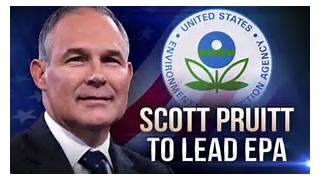

With the San Jacinto site, one of the companies involved has questioned why Pruitt announced a final plan before all data on the hurricane’s impact was in. “Politically, it’s a counter against ‘I’m just listening to industry.'” “Selecting a few remedies that are more expensive allows him to claim that he is protecting the environment,” he said. Mathy Stanislaus, who oversaw the Superfund program during the Obama years, is wary of Pruitt’s public posture.

While acknowledging past EPA leaders have let some sites languish, he worries rushing to get locations off the program’s National Priorities List could mean inadequate cleanups and expose communities to long-term harm. “The whole thing just raises a big red flag to me,” deFur said. Peter deFur, who has consulted on Superfund for more than two decades, remains skeptical of the administrator’s emphasis on speed. In short, Woolford added, “What gets watched is what gets done.” “It elevates the attention and the work that goes into making those decisions happen faster.” And he’ll say, ‘Can you do it sooner than that? Can you do it faster?'” said Jim Woolford, director of an EPA office that helps run the Superfund program. “In the briefings I’ve been in, he has set pretty high expectations for getting work done quickly. Individuals familiar with the process, who spoke on the condition of anonymity to discuss internal deliberations, say Pruitt has asked agency staff briefing him on proposals at certain sites to flesh out more extensive remedies. If he continues to propose aggressive actions around the country – his office last month published a list of 21 places in need of “immediate and intense attention” – it would represent one of the rare areas in which he has pushed to apply a cautionary approach when calculating the risk of exposure to environmental hazards. “Depending on the decision makes,” Chapman said, “he will probably forever remain the hero or the villain in the eyes of this community.”

As is the case in Texas, the companies on the hook for the cleanup contend that years of scientific evidence show capping the waste in place would be safer, cheaper and completed sooner. There are signs he might seek more extensive - and expensive - removal than EPA staff have recommended in the past. Pruitt has promised them he will issue a decision within days. Chapman and other activists are pushing for significant excavation. The landfill there, known as West Lake, contains thousands of tons of radioactive waste from the World War II-era Manhattan Project. “Scott Pruitt is probably the most important person right now in the lives of the people in this community,” said Dawn Chapman, who lives with her husband and three children near a controversial site northwest of St. Residents say they don’t care what his motivations are – if those bring the results they’ve long sought. Yet Pruitt’s attention is shifting the conversation in some beleaguered communities. His critics see it as a political move, an effort to protect himself against charges that he constantly favors corporate interests. His supporters, and Pruitt himself, say it is evidence he is reinvigorating a core function of the agency. In pressing for aggressive, accelerated cleanups, he is butting heads with companies while siding at times with local environmental groups. Pruitt’s approach to the San Jacinto River Waste Pits, as well as to several other Superfund sites around the country, stands in stark contrast to the industry-friendly moves on everything from pesticide exposure to power plant pollution that have defined his first year at EPA. His dramatic decision put Pruitt in unfamiliar territory: Environmental activists cheered, while the targeted firms protested that the directive was not backed by science and could expose more people to health risks. WASHINGTON - Not long after Hurricane Harvey battered Houston last summer, Environmental Protection Agency Administrator Scott Pruitt stood on the banks of the San Jacinto River and surveyed a decades-old toxic waste site as divers checked whether the storm had unearthed dangerous chemicals.ĭays later, he ordered two corporations to spend $115 million to excavate the contamination rather than leaving it covered. Digital Replica Edition Home Page Close Menu


 0 kommentar(er)
0 kommentar(er)
